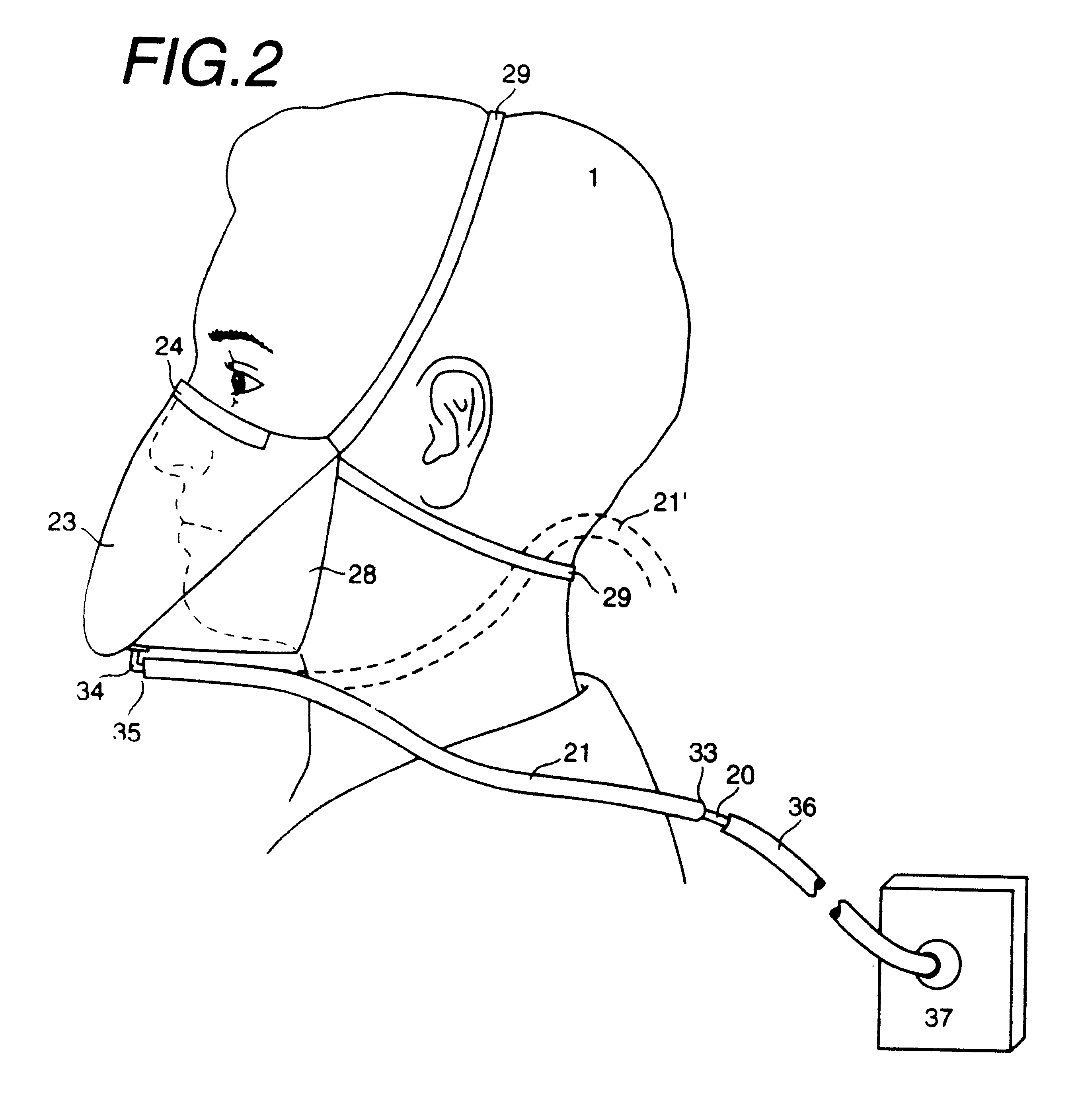Disposable mask and suction catheter
a technology of mask and catheter, which is applied in the direction of respiratory mask, application, respirator, etc., can solve the problems of limiting mobility in equal ways, and achieve the effects of reducing the amount of equipmen
- Summary
- Abstract
- Description
- Claims
- Application Information
AI Technical Summary
Benefits of technology
Problems solved by technology
Method used
Image
Examples
example 1
A mask as described in U.S. Pat. No. 5,322,061 to Brunson and a tubing 21 of about 2.8 mm i.d. and 24 inches in length is placed on a wearer with the mask end of the tubing in communication with the space formed by the mask and face around the nose of the wearer. The wearer performs an operation under conventional operating room conditions. The operation lasts 1 hour. During that hour, the other end of tubing 21 is attached to approximately 16 feet of tubing 36 of 7 mm internal bore, the other end of which is connected to a Guardian liquid collection canister assembly which, in turn, is connected to a wall vacuum outlet. The vacuum measurement at the wall is 23 inches Hg. A liquid catch jar in the canister assembly is upstream of the wall outlet, followed by a regulator supplying a set vacuum of 20 inches Hg to tubing 36. At the beginning of the operation procedure, the catch jar is empty. After the 1 hour period in which the tubing 36 has been connected to the mask / tubing connectio...
example 2
This example shows the effective pressure drop due to tubing. At the wall of a conventional vacuum source in a North Texas hospital, the measured air evacuation rate was at 1400 cm.sup.3 sec. This connection outlet is joined by a standard plastic male-male connector with two sets of tubing each length being 12 feet (3.65 m) long with an internal diameter of 4.8 mm, the tubing purchased from Davol Company, catalog number 3656. A single Guardian canister assembly was arranged between the wall source and the patient, comprising one 3,000 cc Guardian canister. At the end of the 24 feet of Davol 3656 tubing, a 24" (60.96 cm) length tubing is attached with a tubing diameter of 8 French (1.6 mm). The flow rate in the 8 French catheter tubing was measured as 145 cm.sup.3 / sec. The 1.6 mm tubing was considered the minimum size for comfort of use.
example 3
The 24 inch (60.96 cm) section of flexible plastic tubing in Example 2 was replaced with a 2.0 mm i.d. tubing (10 French)section of similar 24 inch length. A 21,000 cc bag was filled with air, connected to the tubing and the air evacuated. The process was repeated three times, timing each time the period of evacuation. The average time of air removal from the bag was 105 seconds. The effective air removal from the bag , then, was 280 cc / sec. This demonstrates the effective air removal by a 2.0 mm tubing in the setup described is 280 cc / sec.
PUM
 Login to View More
Login to View More Abstract
Description
Claims
Application Information
 Login to View More
Login to View More - R&D
- Intellectual Property
- Life Sciences
- Materials
- Tech Scout
- Unparalleled Data Quality
- Higher Quality Content
- 60% Fewer Hallucinations
Browse by: Latest US Patents, China's latest patents, Technical Efficacy Thesaurus, Application Domain, Technology Topic, Popular Technical Reports.
© 2025 PatSnap. All rights reserved.Legal|Privacy policy|Modern Slavery Act Transparency Statement|Sitemap|About US| Contact US: help@patsnap.com



